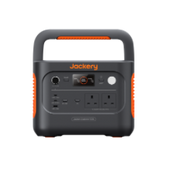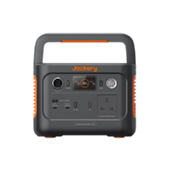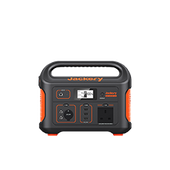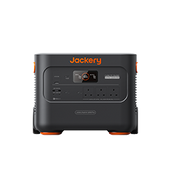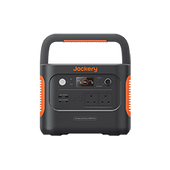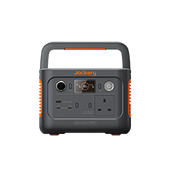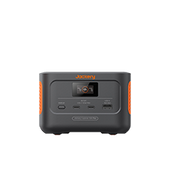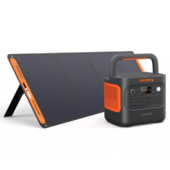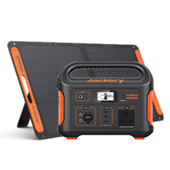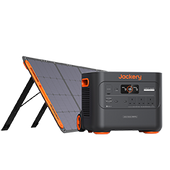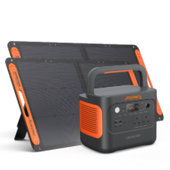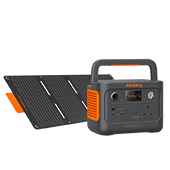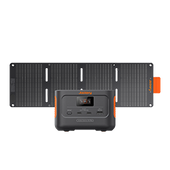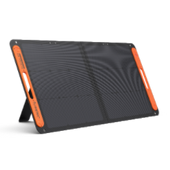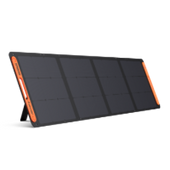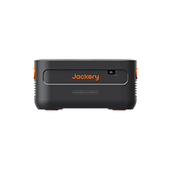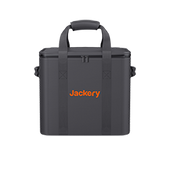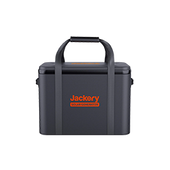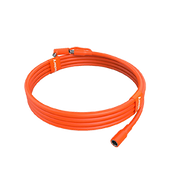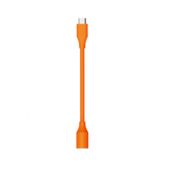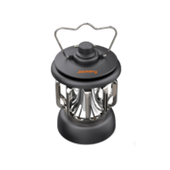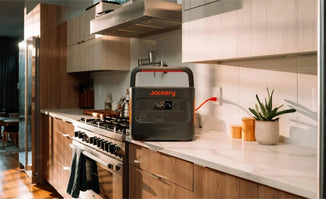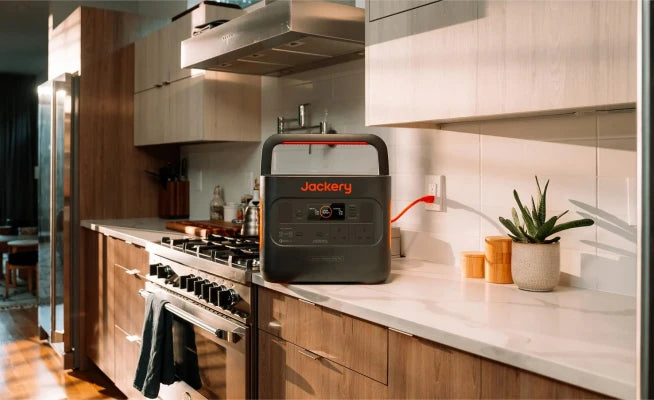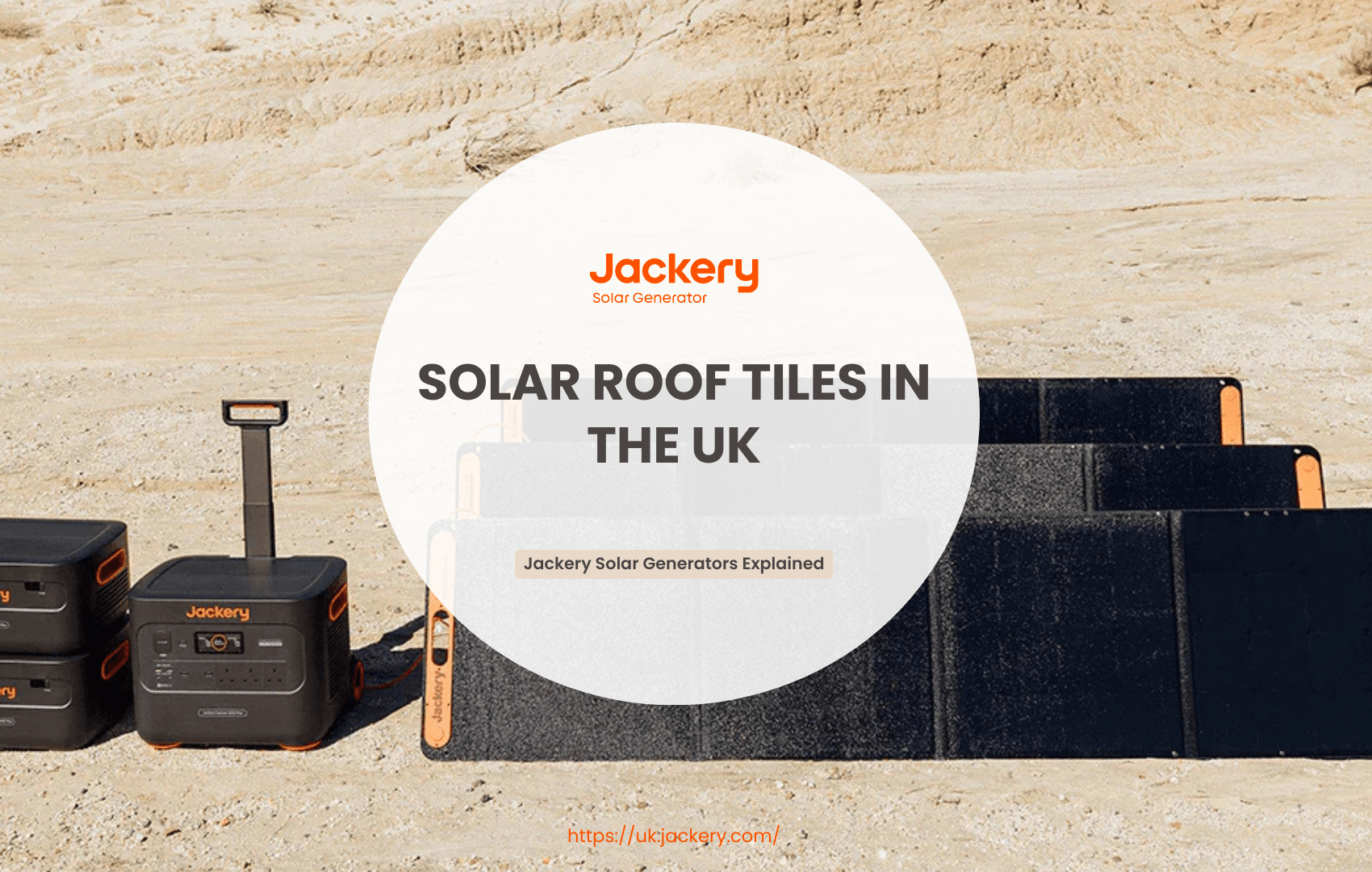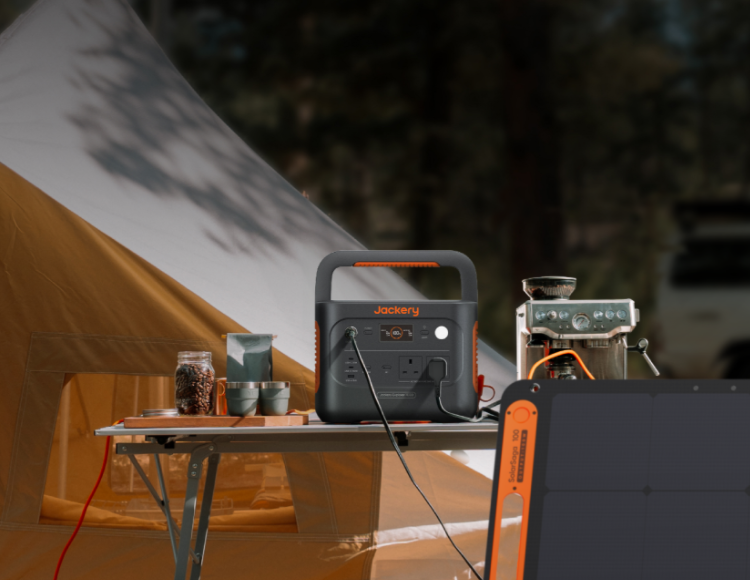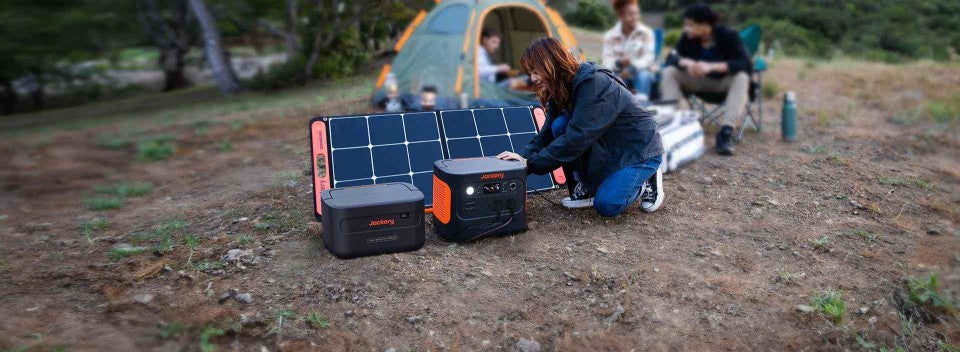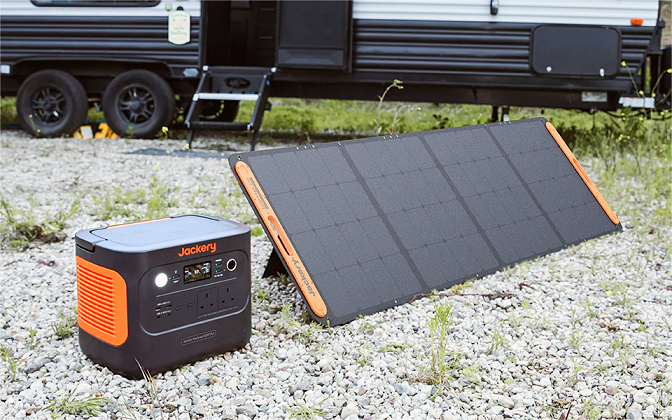You have yet to learn about another solar option: solar roof tiles. These tiles are slightly different from other types of solar technology because they blend seamlessly into your roof while providing green electricity to your home.
Additionally, solar roof tiles are becoming a viable and more aesthetically pleasing alternative to solar panels in the UK. They're also suitable for homes in listed buildings or conservation areas.
This article explores the basics of solar roof tiles in the UK and helps you understand how they differ from traditional solar panels. If you want to try solar energy with a limited budget, you can consider investing in a solar generator, like Jackery Solar Generator, to charge appliances effectively indoors and outdoors.
|
Key Takeaways: |
|
- Solar roof tiles are an innovative solar solution that combines the functionality of traditional roof tiles with the function of generating electricity from solar power. - There are different types of solar roof tiles, such as monocrystalline and thin-film roof tiles. - In the UK, installing solar roof tiles is worth considering. There are many factors to consider when choosing solar roof tiles. - We recommend the Jackery Solar Generator 300 Plus, 1000 Plus, and 2000 Plus portable solar systems for charging low-to-high-end appliances with solar energy. - Solar roof tiles and panels have advantages, and choosing which technology depends on specific needs and preferences. |
What Are Solar Roof Tiles?
Solar roof tiles are an innovative solar solution that combines the functionality of traditional roof tiles with the function of generating electricity from solar power. Unlike conventional solar panels mounted on your roof, solar roof tiles are:
- Your roof.
- Meaning they replace entirely your old tiles.
- Providing an aesthetically pleasing and efficient energy solution.
Solar roof tiles are essentially solar panels disguised as roof tiles. Solar panels or shingles look like regular roof tiles, except they contain photovoltaic (PV) cells and generate electricity. This makes them virtually invisible from the roadside, eliminating one of the significant drawbacks of traditional solar panels.
How do solar roof tiles work?
Solar roof tiles work on the same principle as traditional solar panels, using photovoltaic cells within the tile to capture sunlight and convert it into electricity. Each solar roof tile contains solar cells, typically made from classic single-crystal solar cells or thin-film photovoltaic cells. The solar cells within the tile are made of semiconductor materials, which can convert sunlight into electrical current.
Types of Solar Roof Tiles
As sustainable development becomes more popular, solar roof tiles, an innovative building-integrated photovoltaic technology, are gradually gaining popularity. Solar tiles vary according to the type of solar panel used and the materials used to make them.
Monocrystalline Solar Roof Tiles
Monocrystalline solar cells (a single crystal of pure refined silicon) absorb more sunlight than thin-film solar cells, which can increase solar panel efficiency and power output. They have an efficiency rating of 15-25%.
However, the manufacturing process of monocrystalline solar cell tiles produces silicon waste, which cannot be reused in other monocrystalline solar roof tiles. The battery life of monocrystalline solar cell tiles can reach 25-30 years. However, it can last up to 40 years or more if properly maintained.
Thin-film Photovoltaic Solar Roof Tiles
Thin-film photovoltaic cell tiles are easy to manufacture, require fewer materials, do not contain toxic ingredients, and produce less waste. However, they could be more efficient at generating and producing more power. Still, they are more resistant to high temperatures, and their performance is expected to improve.
Thin-film PV tiles have a shorter lifespan of 10-20 years. However, they have the shortest payback time, meaning the system will save you a lot of money on electricity bills, eventually paying back its initial cost within 8 years.
Top Solar Roof Tile Manufacturers in the UK
The UK is a pioneer in renewable energy technology, and its solar roof tile manufacturers have an essential position in the industry. Three top UK solar roof tile manufacturers lead the new green energy trend with innovative technology and high-quality products.

1. GB Sol
GB Sol is a well-known UK manufacturer specialising in solar roof tiles. They have also developed a PV Slate (which can generate 25Wp to 35Wp of solar electricity and withstand the harsh weather in the UK).
GB Sol produces solar tiles in Wales, ensuring local production and supporting the UK economy. Every solar PV slate GB Sol produces has a ten-year power and product warranty.
Key features of GB Sol's solar roof tiles:
- Long-lasting durability and high energy output
- Beautiful design that blends seamlessly into the roof (designed to be combined with slate roofs)
- High-quality materials and artistry
- Suitable for a variety of building types
2. Solecco Solar
Located in Leeds, UK, Solecco creates a variety of monocrystalline black and polycrystalline red terracotta solar roof tiles that can be integrated into different architectural styles. According to Solecco Solar, each tile produces 15W of electricity with an efficiency of 17. company'scompany'sThe company's solar roof tiles are expected to have a power generation life of 30 years. In addition, Solar Solar's solar roof tiles are made of recyclable plastic rather than glass, which can further reduce the carbon footprint.
Key features of Solecco Solar's solar roof tiles:
- Available in a variety of finishes and multiple tile colours
- Flexible to adapt to different roof types
- high-quality materials for long-lasting use
3. XO Edge
London-based XO Edge offers UV-resistant solar roof tiles (one of the lightest on the market) in a glossy black or silver finish. Made from recycled plaEdge'sXO Edge's solar roof tiles offer aerospace-grade strength, a higher carbon content per square meter than traditional tiles, and are highly efficient at capturing solar enEdge'sXO Edge's solar roof tiles have a peak performance rating of 12W, requiring approximately 84 solar roof tiles per kilowatt of output.
Key features of XO Edge solar roof tiles:
- Made from recycled plastic (eco-friendly choice)
- Lightweight
- Efficient energy conversion
- Fast installation
Are Solar Roof Tiles Better than Solar Panels?
Solar panels and roof tiles are two standard options in solar energy applications. Solar panels installed on roof tiles or slates are a mature green energy solution in the UK.
Solar roof tiles are like miniature solar panels, but they are a relatively new green energy solution that can only be installed as a whole solar roof to replace an existing roof or when a new house is built. So, are solar roof tiles better than traditional solar panels? The following section will compare and analyse the aspects of multiple solar roof tiles and panels.

Aesthetics and Integration
Solar roof tiles have obvious aesthetic advantages. They directly replace traditional roof tiles and blend perfectly with the building. In contrast, solar panels are usually installed as add-ons on existing roofs, which may affect the overall aesthetics.
Efficiency and Performance
Solar panels have been developed for many years, and the technology is mature and efficient. The energy conversion efficiency of efficient solar panels on the market can reach about 20%.
As an emerging technology, solar roof tiles could be more efficient. However, their overall power generation is not necessarily lower than that of traditional panels.
Applicable Scenarios
Solar roof tiles are suitable for new buildings or projects requiring roof renovation, particularly for users who pursue architectural beauty and integrated design. Solar panels are suitable for many existing buildings and are ideal for users who want to install solar systems quickly.
Installation and Maintenance
The installation of solar panels is simple, but cleaning and maintenance are required to ensure efficiency. However, solar roof tiles require the entire roof to be replaced or integrated during new roof construction, and the installation process is relatively complicated. In addition, their maintenance requirements are low, which is no different from those of traditional roof tiles.
|
|
Advantage |
Disadvantage |
|
Solar Panel |
• Environmentally friendly and pollution-free • Economically efficient • Distributed power generation • Low maintenance • Mature technology • Applicable to most roofs |
• Large space requirements • Pollution during manufacturing • Relatively low efficiency • Recycling and disposal issues |
|
Solar Roof Tile |
• Beautiful design • Reduced energy costs • Provides clean, free energy • Increased durability and resistance • Increases the market value of the property • No maintenance required |
• High initial cost • Long installation time • Low efficiency • Severely limited supply • Requires replacement of existing roof tiles • Not all roofs can be fitted with solar roof tiles |
In conclusion, solar roof tiles and panels have advantages and disadvantages. Solar roof tiles may be a good choice if you focus on architectural aesthetics and long-term return on investment. Solar panels are a good choice if you prioritise initial cost and ease of installation.
There is an alternative that doesn't cost too much, like solar roof tiles or solar panels, but still can use solar energy as the fuel - the solar generator. There are many benefits to using solar generators for portable power supply.
Jackery Solar Generators Explained
A solar generator is better than solar panels in portability and immediate power access scenarios. It is designed for easy transport and can deliver on-demand electricity, unlike fixed solar panels, which necessitate installation and depend on sunlight availability for energy generation. Solar generators are ideal for camping, emergency backup situations, or any location needing power without a permanent electrical connection.

Solar generators are portable and compact, enabling relocation as required, whereas solar panels are often stationary installations on rooftops or ground mounts. Here, we will introduce the Jackery Solar Generator, a combination of Jackery Solar Panels with a Portable Power Station for using solar energy on the go.
|
Appliances |
Working Hours |
||
|
Jackery Solar Generator 300 Plus (288Wh) |
Jackery Solar Generator 1000 Plus (1.25-5 kWh) |
Jackery Solar Generator 2000 Plus (2-12 kWh) |
|
|
Fridge (350W) |
0.7H |
3.1-12.1H |
5-29.1H |
|
Computer (200W) |
1.2H |
5.4-21.3H |
8.5-51H |
|
Projector (300W) |
0.8H |
3.6-14.2H |
5.7-34H |
|
Lighting (50W) |
4.9H |
21.4-85H |
34-204H |
|
Phone (10W) |
24.5H |
110-425H |
170-1020H |
Jackery Solar Generator 300 Plus
The Solar Generator 300 Plus bundle is a comprehensive package that includes energy storage and solar panels. Its total weight is about 5kg, rendering it exceptionally lightweight. 40W pad-sized solar panels that capture solar energy have never been more accessible. Our compact, book-sized solar panel is easily foldable and remarkably lightweight, rendering it an ideal portable solar option for your lifestyle.
It is equipped with a 300W AC Pure Sine Wave Inverter (600W Surge Peak) with a capacity of 288Wh. The Explorer 300 Plus can charge up to four gadgets concurrently, utilising one AC, USB-A, and USB-C output, facilitating efficient and rapid charging of numerous appliances. Furthermore, it is sufficiently lightweight and compact to accommodate a rucksack, enabling easy transport.
The MPPT technique guarantees 99% efficiency in solar charging. A complete wall charge requires 2 hours, whereas solar charging with a single SolarSaga 200W panel necessitates 4 hours. With car charging capabilities, concerns over power disruptions will be alleviated.

|
*Review from Our User |
|
I'm impressed; it showed up just in time for my week-long camping trip. It was completely charged in just 2 hours using solar power, which was faster than I anticipated. I've been using it daily and still have 40% remaining after 5 days. This has surpassed my expectations, and I highly recommend it. It's a fantastic way to go off-grid in a campervan without concerns. |
Jackery Solar Generator 1000 Plus
Jackery Solar Generator 1000 Plus combines SolarSaga 100W solar panels with Explorer 1000 Plus. The Explorer 1000 Plus is the same as the Explorer 2000 Plus, which is the expandable LiFePO4 battery to be added to a 5 kWh capacity.
The Explorer 1000 Plus power station boasts an excellent 1264Wh long-lasting LiFePO4 battery and a 2000W full-power pure sine wave inverter, supplying almost all required power. Adding up to three additional battery packs will remarkably increase its capacity to 5kWh.
Adding up to three extra battery packs lets Jackery's exclusive technology boost the Explorer 1000 Plus capacity from 1.26kWh to 5kWh. Moreover, it has a maximum output of 2000W, 20% more than usual 1kWh LFP generators.
The Jackery SolarSaga 100W Solar Panel boasts a solar conversion rate of up to 25%; it is optimally designed for outdoor use and unforeseen power interruptions. The solar panel weighs about 8 lbs, is lightweight, foldable, and equipped with a convenient carry handle, enhancing its portability.

|
*Review from Our User |
|
This sturdy item fits perfectly in my workspace, as shown in the picture. A power outage truly transforms the situation. I can carry on with my tasks as though everything is excellent, which is remarkable. What stands out as the best feature for me? The USB-C connections. I can connect my Mac directly to it; no adapter is required. This is extremely helpful! |
Jackery Solar Generator 2000 Plus
Jackery Solar Generator 2000 Plus is ideal for home, emergency, or outdoor use. It is a solid portable power solution that delivers outstanding performance. With its impressive capacity and powerful output, this device can support the operation of essential appliances for weeks, even certain large appliances, such as your refrigerator, computer, AC, etc.
The Jackery Solar Generator 2000 Plus enables the addition of extra battery packs, increasing the capacity from 2 kWh to an impressive 12 kWh, thereby significantly satisfying your power needs. This solar product has a remarkable output of 3000W, providing a 30% higher rated power than other 2 kWh solar products. Almost all essential appliances are powered.
ChargeShield is Jackery's advanced fast charge technology, featuring 62 protective mechanisms, 12 protective algorithms, and four types of physical safety protection. This technology uses a unique stepped variable-speed charging algorithm to enhance safety and extend battery pack lifespan by 50%.
The Explorer 2000 Plus stands out as a groundbreaking add-on battery pack that offers the convenience of recharging through solar panels. This feature increases versatility, boosts charging efficiency, and shortens charging time. Also, it can be taken indoors safely compared to other traditional generators.

|
*Review from Our User |
|
I have been using Jackery batteries for a long time. I felt great excitement upon the release of the Explorer 2000 Plus, which marks the inaugural release of an expendable battery system by Jackery. The system supports a capacity of up to 12kWh with a 3000W 120V output or 24kWh with a 6000W 240V output—an ideal enhancement for my home backup system. |
How to Choose Solar Roof Tiles?
Solar roof tiles are an innovative solution that is gradually gaining popularity among British families. However, multiple factors must be considered when choosing solar roof tiles to ensure that energy needs, architectural aesthetics, and economic budgets are met.
Aesthetics and Compatibility
The size of the solar tiles must match the existing roof tiles to ensure a neat and beautiful installation. Some solar tile products offer a variety of colours and textures to choose from, allowing the solar system to better integrate into the architectural style and enhance the overall visual effect. In addition, considering that solar tiles need to replace traditional tiles, their size and shape should be designed to ensure good waterproof and ventilation performance.
Durability and Waterproofness
Roof tiles are exposed to the natural environment for a long time and need good durability and waterproof performance. The material should withstand wind and rain erosion and avoid water leakage problems. High-quality solar tiles should be able to work generally in various extreme weather conditions, including strong winds, heavy rain, heavy snow, and high temperatures.
When choosing, you should pay attention to the product's warranty period and the manufacturer's reputation and understand its performance indicators such as wind, pressure, and fire resistance. User reviews and case studies are also important references for evaluating product reliability.
Roof Load-bearing Capacity
The solar roof tiles will increase the roof's weight, so it is necessary to ensure that the roof's structure can support this additional load. The weight of the photovoltaic system needs to be evenly distributed on the roof to ensure structural safety. During the project evaluation stage, a professional structural engineer should be consulted to check whether the roof can safely bear the weight of the solar tiles to avoid safety hazards caused by overloading.
Installation and Maintenance
A professional installation team can ensure the correct installation and optimal performance of the tiles. In addition, consumers should understand the product's maintenance requirements and warranty policies to ensure long-term and stable use.
Are Solar Roof Tiles Worth It in the UK?
Solar roof tiles are gradually entering people's horizons as an emerging technology. This technology is environmentally friendly and saves electricity bills for homes and businesses. However, are solar roof tiles worth investing in in the UK? The following content will analyse whether it is worth investing in solar roof tiles in the UK from multiple perspectives.
Geographical and Climatic Factors
The UK's climate is cloudy and rainy, and sunshine is not as abundant as in some Mediterranean countries. This may affect the efficiency of solar roof tiles.
According to research, solar panels can still generate a certain amount of electricity, even on cloudy days. In addition, the technological advances of modern solar panels enable them to maintain high efficiency even in low-light conditions. Therefore, even in the UK, solar roof tiles can still provide considerable electricity.
Aesthetics and Practicality
With the continuous advancement of technology, solar roof tiles have become more efficient and beautiful. The new generation of solar tiles can simulate the appearance of traditional roof tiles, directly replace conventional roof tiles, realise building integration, and make the overall roof look neater and more beautiful. In addition, solar roof tiles also provide higher energy conversion efficiency.
Environmental Benefits
Solar roof tiles are a clean energy source that reduces a household's carbon footprint and contributes to global environmental protection. Environmental organisations say a typical solar photovoltaic system can offset about 16 tons of carbon dioxide emissions during its life cycle.
Initial Investment and Long-term Benefits
The initial cost of solar roof tiles is relatively high, the first factor many consumers consider. However, in the long run, solar roof tiles can recover costs by saving electricity bills through power generation and even earn additional income by selling electricity to the grid.
In addition, with the advancement of technology and the intensification of market competition, the cost of solar roof tiles is gradually decreasing. The following table lists the average price of solar roof tiles in the UK:
|
Cost of Solar Roof Tiles in the UK |
|||
|
System Size |
Solar Tile Cost (Inc. VAT) |
Labour Cost |
Total Average Cost |
|
1kW |
£5,500 to £7,000 |
£1,800 |
£8,050 |
|
2kW |
£7,000 to £9,000 |
£1,900 |
£9,900 |
|
3kW |
£9,000 to £12,000 |
£2,000 |
£13,000 |
|
4kW |
£10,500 to £16,000 |
£2,200 |
£16,100 |
(Data Source: Green Match)
The data in the table are estimates for reference only. If you want to know the exact price, please contact and ask a professional installer.
Policy Support and Subsidies
The British government is committed to promoting renewable energy development and has formulated policies and regulations to support the use of clean energy.
Although the subsidy policy has been adjusted, the government still encourages households and businesses to adopt solar technology through tax incentives, green loans and other means. In the UK, subsidies to reduce the cost of solar roof tiles:
|
Grants |
Explanation |
Savings |
Eligibility |
|
0% VAT on Solar Panels and Batteries |
Currently, the UK has a 0% VAT policy for solar panels. (This includes solar roof tiles) |
Consumers can save up to £2,850 on a 4kW solar panel system and solar battery. |
This policy is available throughout the UK. |
|
Smart Export Guarantee (SEG) |
Allows the export of excess energy to the grid in exchange for money. |
Rates vary by energy supplier, with the most common rate being 5p per kWh, with some going up to 24p. |
Any MCS-certified solar panel system is eligible for SEG. |
|
The ECO4 Scheme |
Allows the purchase of solar panels completely free of charge. |
The exact grant amount depends on the home inspection and appraisal. |
This policy is available throughout the UK, prioritising low-income households. |
Although the initial investment is high, the savings on electricity bills and policy subsidies can recover the cost in the long run. In conclusion, installing solar roof tiles in the UK is an investment worth considering.
Solar Roof Tiles in The UK FAQs
The following are the frequently asked questions about the solar roof tiles in the UK:
- Are solar roof tiles worth it?
Whether solar roof tiles are worth the investment remains a question of weighing importance for many consumers. Solar roof tiles have significant advantages in energy saving and emission reduction, service life, aesthetics and safety, but their main disadvantages are high initial investment and installation complexity.
Solar roof tiles are undoubtedly a choice worth considering for families with financial resources who pay attention to environmental protection and long-term benefits. At the same time, with the advancement of technology and policy support, the cost of solar roof tiles is expected to be further reduced, and the penetration rate will also gradually increase.
- What are the disadvantages of solar tiles?
While solar roof tiles offer significant aesthetic and functional advantages, there are also some significant disadvantages.
- High cost.
- Complex installation.
- Affected by weather.
- Limited colour and style choices.
- Limited scope of application.
- Supply is strictly restricted.
- Not all roofs can be installed with solar roof tiles.
- How much do solar tiles cost in the UK?
Solar roof tiles, a relatively new technology in the UK, can cost twice as much as traditional solar panels. In addition, the size of the roof and the proportion of the roof to be covered with solar panels will affect the installation cost of solar roof tiles.
For example, solar roof tiles cost around £5,500 – £7,000, including VAT, for a 1kW system, with installation costs around £1,800. Thus, the total solar roof tiles cost for a 1kW system size is approximately £8,050.
Final Thoughts
Although solar roof tiles are not widespread in the UK, they are moving from a high-end product to a common alternative to "bolt-on" solar panels. After considering various factors and weighing the pros and cons, the question remains: are solar roof tiles worth it in the UK? Whether solar roof tiles are worth it in the UK depends on your circumstances, priorities and long-term goals.
In short, solar roof tiles are the perfect choice for those who want cheaper energy bills and renewable energy but don't like the look of solar panels.



